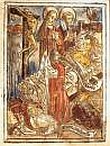If someone asked you to explain the principle of supply and demand, could you do it? What if someone asked you to apply the principle to explain the current state of the rare book market, would you be able to? The latter may not be as simple to explain by using the basic theory of supply and demand. In fact there are segments of this market that exhibit behavior that is quite difficult to justify in terms of simple economic theory. A perfect example of this is the market for “block books.”
Among the rarest and most valuable of books are the so-called block books. Usually consisting of 50 or fewer leaves, this early form of printing was very popular in the second half of the 15th century. The technique offered a cheaper alternative to the printed book, which at the time was still very expensive to produce. Block books were printed using wood blocks in which the text and illustrations were both cut in relief, and the impression was taken from the solid block instead of using Gutenberg’s invention of movable metal type. Some block books, called chiro-xylographic (from the Greek chir (χειρ) “hand” and xilo (ξyλo) “wood”) contain only the woodcut illustrations, with the text written by hand. The appearance of books using this technology began in the 1450’s and extended into the 1470’s when it proved ideal for the printing of small editions without incurring the labor cost of setting the type. The content of the books was for the most part consisting of religious iconography.
It is not difficult to see that the availability of block books is indeed very limited. This by default is a cause for sellers to price high and ignore the other side of the market: the demand. Unfortunately for these sellers, demand for this type of book is not at all exciting for a number of good reasons:
1) Institutions that normally acquire these books, such as libraries and museums, have reached the level of excess and are facing budget constraints.
2) Lack of Individual collectors specializing in block books. Requires extensive knowledge and research on provenance.
3) Available copies have undergone significant restoration requiring expert assessment of historical records and material used.
4) More appealing copies with colored woodcut pictures are the result of contemporary hand-coloring than original work.
5) High prices and logistic difficulties discourage on-line trading that bypass detail examination of item.
Given the lack of interest for block books in recent years the remaining question is why prices have not come down. If institutions that are the primary buyers of this nature of books are not aggressively picking them up, what type of strategy have the sellers adopted to counteract? On the surface it looks like targeting a very specialized group of buyers from institutions requires a long-term approach to marketing. The original assessed value remains relatively constant while market forces lack liquidity. In fact, most of the trading of such books is conducted in an auction type of exchange where liquidity is often provided at the high bid amount.
In such an auction event held by Sotheby’s in July of 1910 in London, a worn, mended “block book” in modern calf, from the library of Thomas Gray of Dowanhall Glasgow, containing twenty-four letters and six leaves of ribbon letters, with the letter “A” dated 1464, was sold for $7,600. Despite this “block book’s” defects the price paid was not considered too high then, as only one other alphabet of this kind was known, now in the British Museum. To get a better understanding of the value of a $7,600.00 book in 1910 relative to 2012, one can project the increase in dollars using the following options:
- Real Price. Relative cost fixed over time, based on CPI (Consumer Price Index). In other words taking just inflation into account, the increase comes to $186,000.
- Labor Value. Measured using the relative wage of an unskilled worker based on the Wage Indexes, the current increase is $753,000.
- Income Value. Using the GDP (Gross Domestic Product) per capita, to compute the relative average increase to buy the book, the increase becomes $1,020,000.
Not too bad for a book deemed defective. While today it would be very difficult to find an original wood cut grotesque alphabet similar to the one sold in 1910 to compare apples to apples, there are still a number of block books for sale at significantly lower prices than even the $186,000 inflation adjusted figure. Another potential indication of how under-valued today’s rare book market is measured to be.


{ 0 comments… add one now }
{ 1 trackback }